35 lost treasures waiting to be found
Amazing treasures that could still be found

Leon Neal/Getty Images
From the Crown Jewels of Ireland to the lost Imperial Fabergé eggs, and even a solid gold toilet, amazing treasures totalling billions remain missing to this day.
Read on to discover 35 lost, stolen or simply hidden valuables that are still waiting to be discovered. All dollar amounts in US dollars.
Ark of the Covenant

Zoonar GmbH / Alamy Stock Photo
The Ark of the Covenant is considered one of the most sacred objects in the Bible, built by the Israelites around 3,000 years ago to house the stone tablets the Ten Commandments were written on. It's linked to numerous miracles in the Old Testament, and interpretations of what the golden chest may look like can be found across biblical artwork, such as in The Ark Passes Over the Jordan, which was painted by James Tissot in 1902.
But when the Babylonian Empire defeated the Israelites in the 6th century BC, all mention of the Ark disappeared. What really happened to the Ark of the Covenant remains a mystery, but there are hopes that it has simply remained hidden all these years. There are whisperings the Ark could be concealed within the St Mary of Zion Cathedral in Ethiopia (pictured) but it's never been seen or confirmed by experts. Other stories suggest it was buried under the First Temple in Jerusalem, where the sacred Dome of the Rock shrine lies today, making digging to look for it impossible. However, the chest may have been stolen or, worse, destroyed.
Padmanabhaswamy Temple treasure

alionabirukova/Shutterstock
Known as the richest temple in the world, Padmanabhaswamy Temple in Kerala, India, houses several underground vaults filled with unbelievable treasures. In 2011, when one of the secret chambers was finally opened after centuries, gold jewellery, ornaments, crowns and precious stones estimated to be worth $22 billion (£17bn) were found. Overall, researchers believe the temple could hide treasures worth up to $1 trillion (£764bn).
There's a problem though: nobody will dare open the remaining vaults. According to an ancient legend, the treasure is protected by two giant serpents and anyone who opens the doors will be cursed.
Flor de la Mar
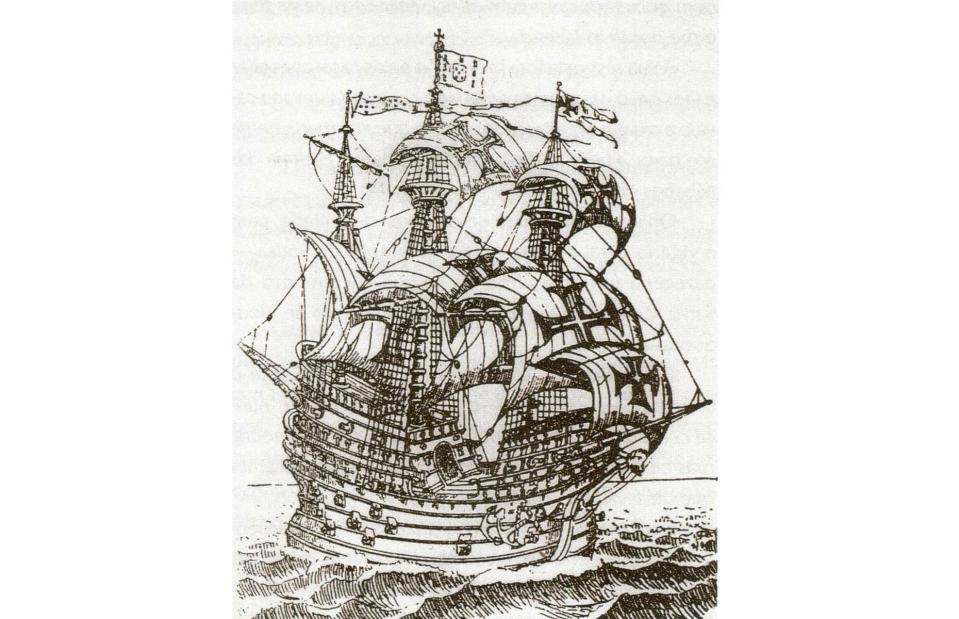
Francisco RodriguesJoaquim de Mello (book author), Public domain, via Wikimedia Commons
A number of lucrative shipwrecks have been discovered in recent years, including the famed San José Spanish Treasure Galleon. But the Flor de la Mar, which was lost off the coast of Sumatra, Indonesia, in November 1511, is still out there.
The 400-ton Portuguese vessel was laden with lavish treasures, including gold goblets, precious jewels, and vast amounts of gold bullion worth $2.6 billion (£2bn) in today's money. But for now they remain lost to the sea.
Treasure of the Llanganates

Girolamo Benzoni, Public domain, via Wikimedia Commons
In 1532, Spanish conquistador Francisco Pizarro captured Inca Emperor Atahualpa at Cajamarca in modern-day Peru. The emperor promised to fill an entire room with gold and another with silver to secure his release, but before the precious metals could be delivered, the Spanish murdered their captive.
According to legend, Inca general Rumiñahu, who was transporting the gold and silver, buried the stash in a cave or dumped it in a lake in Ecuador's Llanganates Mountains. Archaeologists are divided as to whether the hoard is still out there, but that hasn't stopped adventurer after adventurer trying their luck. Could this be the year it's found? Time will tell.
Blenheim Palace’s gold toilet
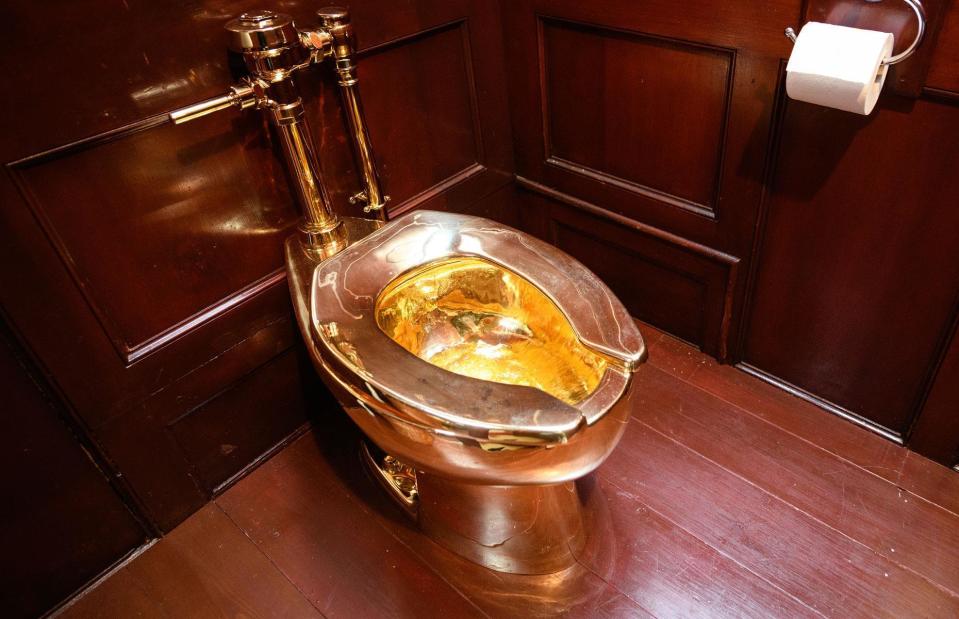
Leon Neal/Getty Images
Artwork and gold feature heavily in this round-up, but how about a combination of the two in the form of this solid gold toilet? The fully functioning bathroom art, entitled America, was created by Italian artist Maurizio Cattelan and was part of an exhibition at Blenheim Palace, England. It was stolen just one day after its grand reveal in September 2019. Many believed the theft was a prank by the artist – known for his elaborate stunts – but that wasn't the case, and a £100,000 ($131k) reward was offered to anybody who could return the toilet.
Seven people were arrested in connection with the crime over the next few years. However, we didn't have a potential answer to Cattelan's incredulous question, "Who's so stupid to steal a toilet?" until this year, with reports that four men have been charged over the theft. Though at least one of the men has since pleaded guilty, the whereabouts of the toilet, which has been valued at around $5.8 million (£4.4m), remains unknown.
San Miguel

Kostyantyn Ivanyshen/Shutterstock
Another lost shipwreck, the San Miguel Spanish Treasure Galleon is yet to be located. The ship was destroyed in a hurricane on 29 April 1551 off the coast of Santo Domingo in what is now the Dominican Republic. It's thought to have been carrying cargo valued at $2 billion (£1.5bn).
Shipwreck hunters have been looking for the San Miguel for centuries yet the wreck remains undiscovered. The search in the seas around the Dominican Republic is ongoing, so there's a chance the treasure-laden vessel could be found.
Merchant Royal
![<p>Robert Salmon [Public domain], via Wikimedia Commons</p>](https://s.yimg.com/ny/api/res/1.2/ZSGEM4YpOqleqWppSrgzcQ--/YXBwaWQ9aGlnaGxhbmRlcjt3PTk2MDtoPTYxOQ--/https://media.zenfs.com/en/lovemoney_uk_264/c7ad456b94139bde209924f40eebde6e)
Robert Salmon [Public domain], via Wikimedia Commons
When the Merchant Royal sank after hitting bad weather in 1641, reportedly near the Isles of Scilly, it took 100,000 pounds of gold, 400 bars of Mexican silver, and some 500,000 coins down with it. Treasure hunters need to be well equipped if they want to find the lost wreck in the Cornish sea, as the water is up to 300 feet (91.4m) deep and the weather can be stormy.
The anchor from what's thought to be the most valuable shipwreck ever was found off the coast of Cornwall, England, in March 2019, giving treasure hunters a hint as to where its load – worth more than $1.5 billion (£1.1bn) – might be. Pictured is a merchant ship similar to the one that was lost.
Oak Island Money Pit Treasure
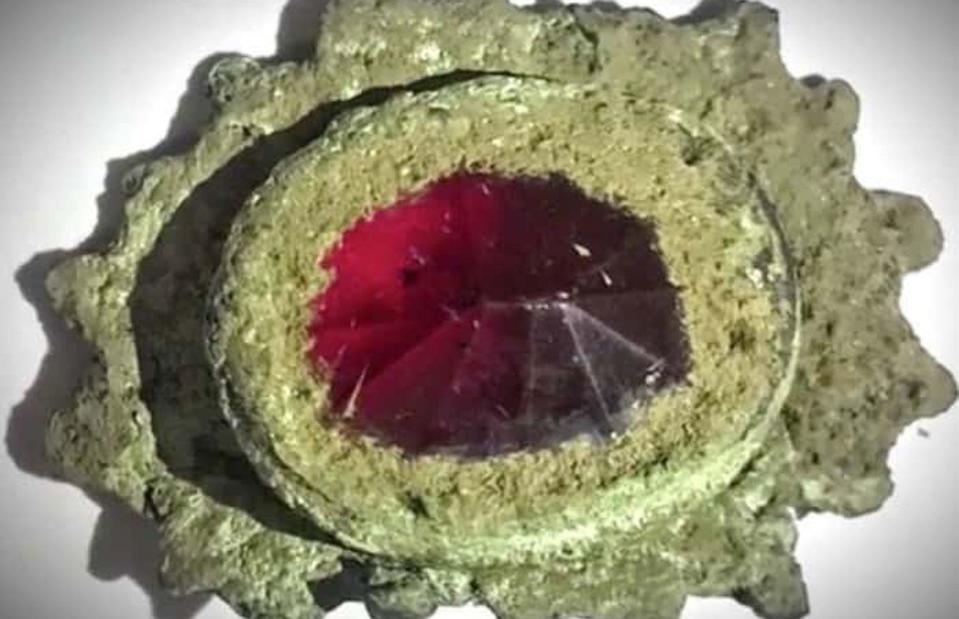
Courtesy History Channel
This fabled treasure, which is said to be buried in the booby-trapped 'money pit' on Oak Island in Nova Scotia, Canada, has thwarted adventurers for three centuries and has been the subject of a History Channel TV show.
The show's treasure hunters hit the jackpot in early 2018 when they unearthed actual treasure on the site: a gemstone-studded brooch. Gold has since been discovered on the island, increasing the probability of further discoveries. If the theories are to be believed, everything from millions in cash to Shakespeare's lost folios, Queen Marie Antoinette of France's jewels, and even the Holy Grail are buried on the island.
Blackbeard’s treasure
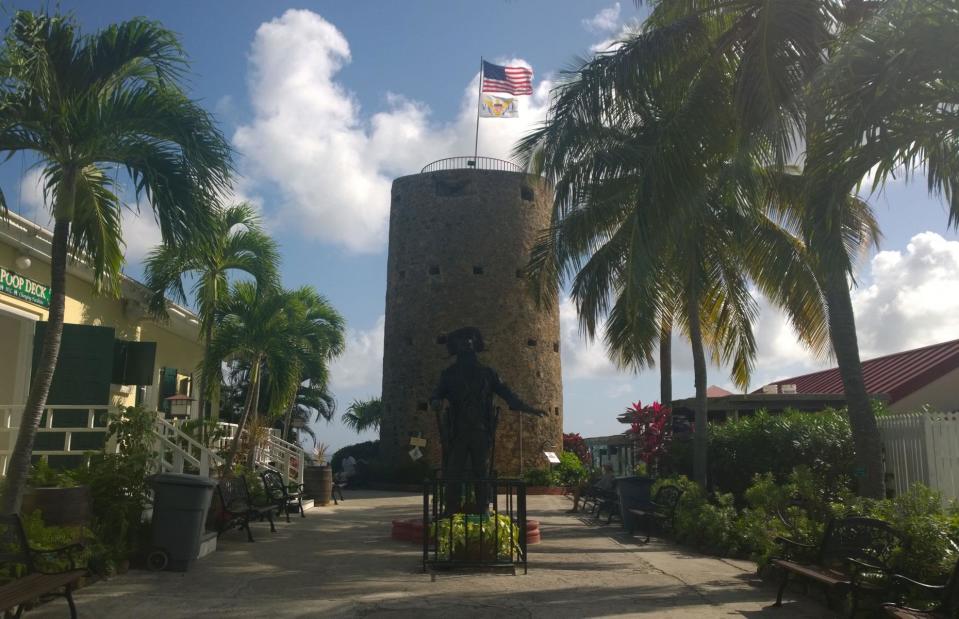
Onegirlriot/FlickrCC
Edward Teach, better known as infamous pirate Blackbeard, spent years terrorising the Caribbean in the early 18th century, looting and pillaging vessel after vessel from his flagship, the Queen Anne’s Revenge. Blackbeard stole everything from gold bars to precious jewellery, likely worth millions in today’s money. It's believed this real-life pirate of the Caribbean stashed his booty on surrounding islands and parts of North Carolina.
Some of the pirate’s thieved goods surfaced in 1996 when his shipwreck was excavated, and among the treasures was a diamond-encrusted wine glass stem adorned with gold crowns. Treasure hunters weren’t satisfied with the find however, and many believe that most of the riches are still out there somewhere, scattered across Blackbeard’s various stomping grounds. Blackbeard’s Castle on the US Virgin Island of St. Thomas (pictured) and Plum Point in North Carolina have been named as possible hiding spots.
Mosby’s Stolen Civil War Treasure

Berean Hunter/Wikimedia Commons
The American Civil War saw countless treasures stolen, and millions of dollars’ worth is believed to be lost to this day. One particularly ambitious thief, Confederate ranger John Singleton Mosby (pictured), gathered a team of accomplices and launched a night raid on the Fairfax County Courthouse, Virginia in 1863. Inside the building they found a sack of gold, silver, and jewels belonging to the county’s most prominent families. The audacious crew made off with the bag of treasure, which is believed to have a value of $6 million (£4.6m) in today’s money.
As the gang escaped back to the Confederate lines, Mosby decided that burying the treasure was the best way to avoid being captured by Union soldiers, who would then undoubtedly confiscate the sack of jewels. A couple of months later Mosby sent some of his men back to retrieve the treasure, but they were caught and hanged by soldiers. The frontman of the operation never made it back to his loot, and the stash is still buried there today.
Looted Civil War Confederate Gold

PhotoBC/Shutterstock
More Civil War treasure that went astray – this time in the form of a boxcar stuffed with gold bullion worth upwards of $140 million (£107m). The heap of precious metal is believed to be sitting somewhere at the bottom of northern Lake Michigan. Union soldiers had swiped the gold from Confederate President Jefferson Davis in 1865 after being captured and imprisoned in Virginia, according to a History Channel documentary following two treasure hunters on the lookout for the booty.
Two keen treasure hunters, Kevin Dykstra and Frederick J. Monroe, have been piecing together the mystery based on a deathbed confession from a local lighthouse keeper in 1921. He claimed that the bullion had been stashed onto a train boxcar and smuggled north, in the direction of Lake Michigan. It was then loaded onto a ferry, but for unknown reasons, it was thrown overboard. Dykstra and Monroe claimed to have found one of the many gold bars, but their find is unconfirmed. If the story is true, there's gold aplenty still waiting to be found...
Jesse James’ gold

Michael/Wikimedia Commons/CC BY 2.0
Wild West outlaw Jesse James made a name for himself in the 19th century as a prolific bank and train robber across the Midwest. James is believed to have buried at least one of his hoards, which is thought to be worth around $3 million (£2.3m) in today’s money, somewhere in Canada. Legend has it the robber and his band of accomplices were on the run from the US police after looting a Wells Fargo train in 1870 and decided to flee north to avoid capture.
The treasure is believed to be buried near Mulmur, Ontario (pictured), around two hours away from Princeton, where James allegedly built a home. An Englishman called Tom Vickers visited the site in 1958 and said: "If the boys [James’ gang] were ever here and wanted a place to hide the gold, this spot is just about perfect." It remains unknown as to whether the gold was ever recovered.
Flagstaff outlaws’ loot

Netfalls/Remy Musser/Shutterstock
Wells Fargo’s treasures fell into the hands of criminals yet again on 10 May 1881, when a stagecoach full of silver and gold bars was looted in the mountains near Flagstaff, Arizona. Like Jesse James' gold, the value of this hoard is believed to be more than $3 million (£2.3m) in today’s money. One of the bank’s employees is rumoured to have tipped off the crooks, allowing them to find the vehicle as it travelled to a branch in San Francisco. Local sheriffs and army cavalry chased the bandits to a remote cabin in the mountains, and a frenzied shootout followed.
None of the robbers made it out of the cabin alive, but curiously there was no gold or silver to be found in the building or surrounding area. The cabin owner is believed to have spent 30 years looking for the treasure. In 1913, a local character called Short Jimmy McGuire claimed to have found several gold coins, but he suddenly died of a heart attack before sharing the location, leaving the treasure’s hiding place a mystery…
Lost Dutchman's Gold Mine

Tony the Marine/Flickr CC
America's most famous lost mine, the Lost Dutchman's Gold Mine is said to be located somewhere in Arizona's rugged Superstition Mountains. The mine is named after 19th-century immigrant Jacob Waltz, who reportedly left gold there worth around $200 million (£153m) in today's money.
An estimated 500 adventurers have died looking for the mythical treasure, making the search for Lost Dutchman's Gold Mine the most dangerous treasure hunt in the world. Here's hoping the treasure is found soon, so the deadly search can be called off once and for all.
Lost Imperial Fabergé eggs
![<p>AnonymousUnknown author [Public domain], via Wikimedia Commons</p>](https://s.yimg.com/ny/api/res/1.2/H0t8_hkttURkWjRFMtrfIQ--/YXBwaWQ9aGlnaGxhbmRlcjt3PTk2MDtoPTYxOQ--/https://media.zenfs.com/en/lovemoney_uk_264/9dda2abfeb683b5047fa90c4e674016f)
AnonymousUnknown author [Public domain], via Wikimedia Commons
The ultimate Easter egg hunt, seven of the 50 Fabergé eggs that were crafted for the Russian Imperial family during the late 19th and early 20th centuries are lost and out there waiting to be discovered, assuming they haven't been broken up or melted down.
The lost eggs include the 1888 Cherub with Chariot, the Nécessaire from 1889, and the 1903 Royal Danish (pictured), each of which are worth around $30 million (£23m). The Third Imperial Egg turned up in 2012 at a jumble sale in the American Midwest of all places, so there's every chance more could be found.
Crown Jewels of Ireland
![<p>Dublin Police (Life time: 1907) [Public domain], via Wikimedia Commons</p>](https://s.yimg.com/ny/api/res/1.2/dnq6Vd10hLL3E7DLuxWsPw--/YXBwaWQ9aGlnaGxhbmRlcjt3PTk2MDtoPTYxOQ--/https://media.zenfs.com/en/lovemoney_uk_264/a5255869c23571db525c661c8c55dd7e)
Dublin Police (Life time: 1907) [Public domain], via Wikimedia Commons
The Irish Crown Jewels were stolen in 1907 from a safe in Dublin Castle. The jewels, which include a gemstone-encrusted star and badge of the Order of St Patrick, have never been located, though they are thought to be buried somewhere in the Wicklow Mountains.
Police have used metal detectors to search for the $20 million (£15m) jewels at several sites in the Wicklow Mountains, but the luck of the Irish hasn't been on their side. It's illegal for civilians to metal detect for historical items in Ireland, making it almost impossible for the average person to find this lost treasure, so hope is pinned on the authorities.
Van Eyck’s The Just Judges Panel
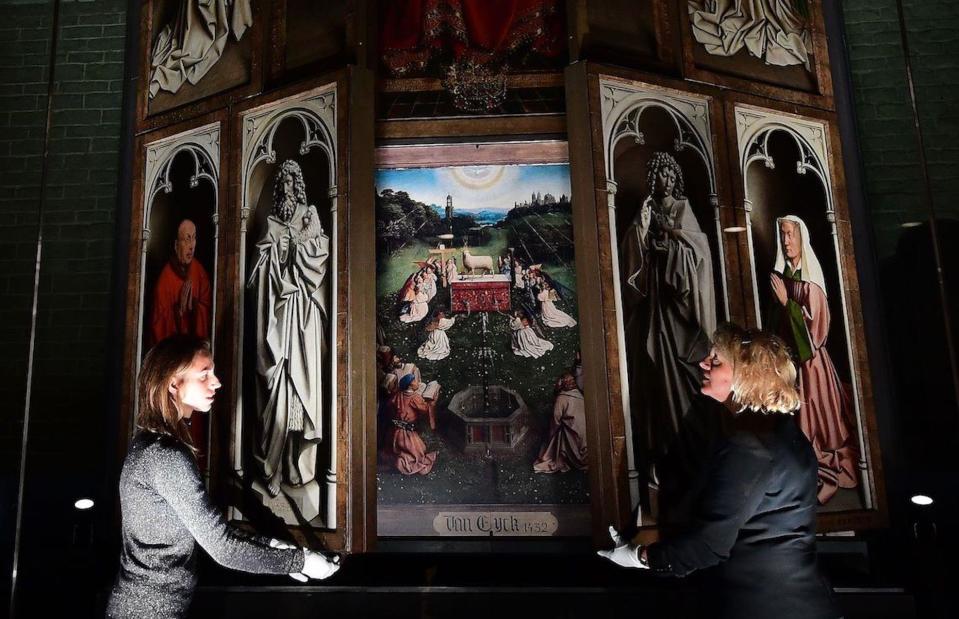
EMMANUEL DUNAND/AFP via Getty Images
Hubert and Jan van Eyck’s Adoration of the Mystic Lamb has been described as the “most stolen artwork of all time”, after disappearing multiple times since its conception in the 15th century. First, the 12-panel piece was nearly burned by the Calvinists, then it was stolen by Napoleon, and then taken yet again during World War I. The panel, depicting the so-called Just Judges, was stolen from the Saint Bavo Cathedral in Ghent, Belgium in April 1934, and more than 85 years later its whereabouts remains unknown.
The other 11 panels have since returned to the Belgian cathedral, having been stolen yet again during World War II. The suspected thief of the remaining panel, Arsène Goedertier, was denied the one million Belgian francs he asked for in ransom money and refused to reveal where he had hidden the artwork even as he lay on his deathbed. The latest update in the case is that experts believe the painting could lie beneath one of the major squares in Ghent, but the location hasn’t been investigated further as authorities are reluctant to dig up the paving stones. Until they change their minds, the disappearance of the Just Judges panel remains a mystery.
John Dillinger's suitcase of small bills

Bettmann / Contributor / Getty Images
John Dillinger was a gangster who rose to fame in America during the Great Depression. Three months before he was shot by police in Chicago, he’s rumoured to have buried a suitcase containing $200,000 in small bills in Wisconsin woodland. Dillinger didn’t get the chance to recover the money and it has never officially been found.
If the money still exists, it could be worth over $3 million (£2.3m) today. Dillinger was hiding at the Little Bohemia Lodge in Manitowish Waters, Wisconsin, and it’s thought he buried the treasure just a few hundred yards from the site.
Raphael’s Portrait of a Young Man

Raphael/Public domain/Wikimedia Commons
This portrait by Raphael is widely regarded to be the most important painting to have gone missing since World War II. Painted in 1513-14, Portrait of a Young Man was stolen from the Czartoryski Museum in Krakow, Poland by the Nazis in 1939. The Third Reich plundered an estimated 20% of European art during the war, and much of it remains missing today.
The oil painting is believed to have a staggering value of more than $100 million (£76m) in today’s money and was stolen so that it could decorate Hitler’s residence in Berlin. The masterpiece was then appropriated by Gestapo official Hans Frank, the then Nazi Governor-General of Poland, for his villa in Neuhaus, Germany. The painting disappeared in transit between Poland and Germany and has not been seen since the end of World War II.
Rembrandt’s An Angel with Titus’ Features

Rembrandt van Rijn/PD-1923
Another artwork stolen by the Nazis is An Angel with Titus’ Features by Rembrandt, which depicts the Dutch master’s son. The painting had been kept in a chateau in the French countryside but was stolen during the invasion in 1943. Soldiers took the piece to Paris, where it was set aside to be installed in Hitler’s Führermuseum.
Despite having failed to become an artist himself, Hitler fancied himself as a critic and collector and hoped to establish the Führermuseum in Linz, Austria, where he had spent his childhood. The collection would have exhibited around 300 treasures stolen by the Third Reich, and was designed to look like the House of German Art, which he did manage to establish in Munich. More than 160 pieces of artwork have been recovered since then, but Rembrandt’s portrait remains missing.
Michelangelo’s Head of Faun
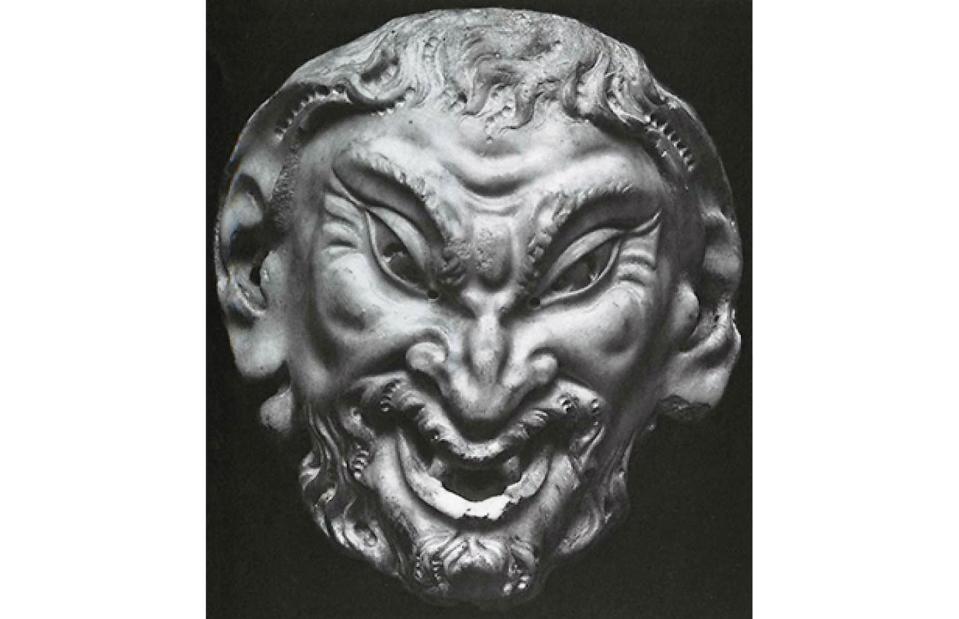
Courtesy Monuments Men Foundation
This sculpture was the first known to have been created by Renaissance master Michelangelo, and it dates back to around 1489. The painter famous for decorating the ceiling of the Sistine Chapel is believed to have created this marble artwork when he was just 15 or 16 years old, and it won him the patronage of the powerful Florentine leader Lorenzo de’ Medici.
The priceless sculpture was displayed in the Bargello Museum in Florence until 1944, when its collection was plundered by the Nazis. Some experts have suggested the sculpture could have found its way to the Soviet Union, but as with many pieces stolen during World War II, it remains lost.
Amber Room
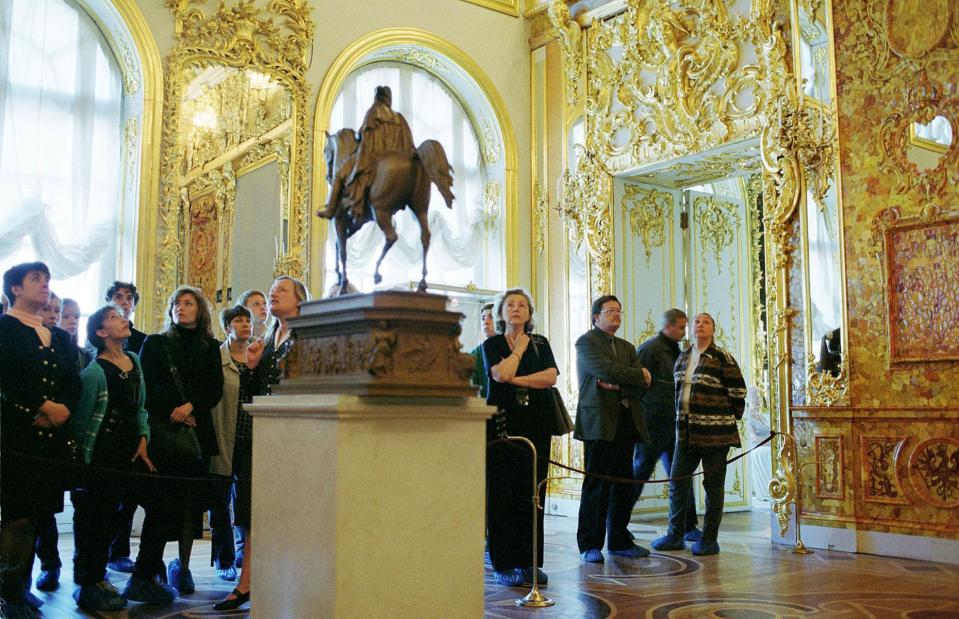
Oleg Nikishin/Newsmakers/Getty
Regarded as the 'Eighth Wonder of the World', the breathtaking Amber Room at the Catherine Palace near St Petersburg was created for Frederick, the first King of Prussia, in the early 18th century. An opulent chamber of exquisite amber panels backed with gold leaf and ornate mirrors, the Amber Room disappeared towards the end of World War II.
Theories abound as to its whereabouts, but the spectacular treasure has never been located. Thankfully, experts were able to create an exact replica of the Amber Room (pictured) in 2004 using original drawings and old photos.
Nazi Gold Train
![<p>Chmee2 [CC BY-SA 3.0], from Wikimedia Commons</p>](https://s.yimg.com/ny/api/res/1.2/M55mEK3CCVp9i2H.3zc4FA--/YXBwaWQ9aGlnaGxhbmRlcjt3PTk2MDtoPTYxOQ--/https://media.zenfs.com/en/lovemoney_uk_264/7c233e7782009092fca0e060bf4c74b7)
Chmee2 [CC BY-SA 3.0], from Wikimedia Commons
Local rumour has it that a Nazi train loaded with tons of pillaged valuables was buried in the Project Riese complex of tunnels near Walbrzych in Poland in January 1945, as World War II was coming to an end. The stash, if it exists, would be worth billions of dollars in today's money.
The train, which may even contain the lost Amber Room, has inspired numerous searches but its whereabouts, and even its very existence, remain shrouded in mystery. However, hunts for the treasure continue to this day.
Lake Toplitz treasure

Public Domain/Wikimedia Commons
About 40 miles southeast of Salzburg, Austria lies a lake surrounded by mystery. As World War II came to a close, and US troops were closing in, a group of Nazis dumped several boxes in Lake Toplitz, which was part of a Nazi naval base at the time. There's been much speculation as to what was in the boxes, from looted European gold – as much as $5.6 billion (£4.3bn) worth of stolen gold could be lying in the lake if stories are to be believed – to documents showing where items taken from Jewish people during the war had been held.
However, at least seven divers have lost their lives in perilous attempts to retrieve the supposed treasure from the ice-cold, 300-feet-deep lake. In 2005, Bundesforste AG, the Austrian state company in charge of the lake, agreed that American treasure hunter Norman Scott could dive in the lake in the hope of finally solving the mystery, but he found nothing.
Patiala Necklace

Shaun Curry/AFP/Getty
Cartier crafted this opulent necklace in 1928 for Bhupinder Singh of Patiala, the then Maharaja of the state of Patiala in India. Dripping with 2,930 diamonds, the necklace contained the 428-carat De Beers diamond, the seventh largest in the world, which would be worth $30 million (£23m) in today's money.
The stunning piece of jewellery went missing from the royal treasury of Patiala in 1948, and while parts of the necklace have been found, including the De Beers diamond which has enabled Cartier to recreate the piece, the Burmese rubies and scores of diamonds remain missing.
Caravaggio’s Nativity with St. Francis and St. Lawrence
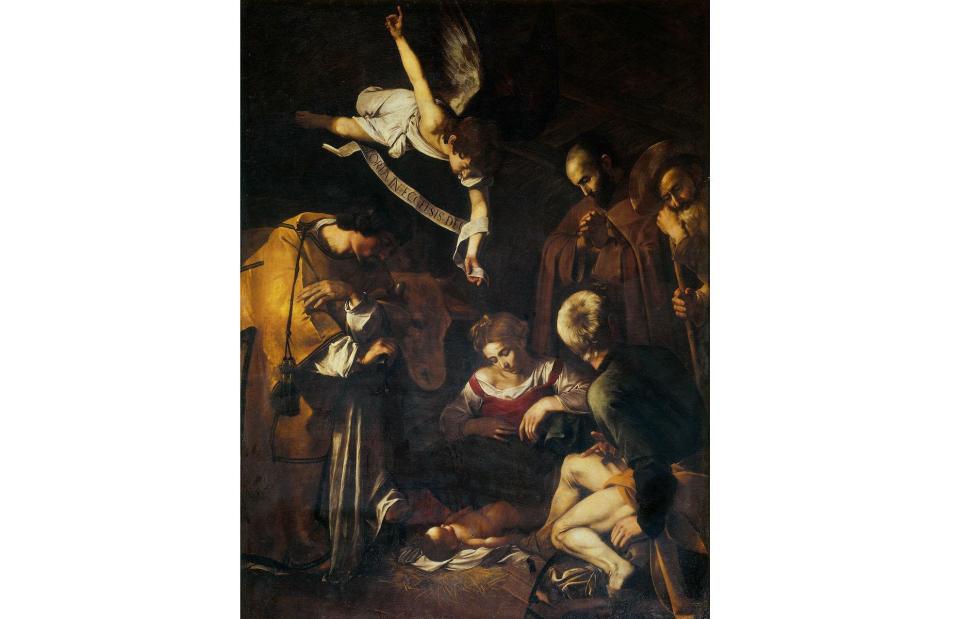
Michelangelo Merisi da Caravaggio/Public domain/Wikimedia Commons
This 1609 painting by Italian Baroque master Caravaggio hung above the altar of the Oratory of San Lorenzo in Palermo, Italy for more than 300 years. One stormy night in October 1969, the Sicilian Mafia is believed to have cut the nativity scene from its frame, likely because it has an estimated value of $20 million (£15m), and so the painting vanished…
Nativity with St. Francis and St. Lawrence has since been dubbed one of the FBI’s most wanted stolen artworks, as it still hasn’t been recovered. A replica was commissioned to fill the empty frame in 2015 (pictured), while detectives continue to look for the missing masterpiece. The most recent development in the case saw the Mafia slice off a piece of the painting to try and convince the Catholic Church to cut a deal for its return. Police are also investigating claims that the Mafia has been in touch with an art dealer in Switzerland.
Van Gogh's Poppy Flowers
![<p>Vincent van Gogh [Public domain] Wikimedia Commons</p>](https://s.yimg.com/ny/api/res/1.2/VwRQC5EMrXh.7mUTow6taA--/YXBwaWQ9aGlnaGxhbmRlcjt3PTk2MDtoPTYxOQ--/https://media.zenfs.com/en/lovemoney_uk_264/e62480928327bcc4cd60148d188bb5aa)
Vincent van Gogh [Public domain] Wikimedia Commons
Valued at a hefty $55 million (£42m), this depiction of yellow and red poppies, painted by Vincent Van Gogh in 1887, has been stolen twice. In 1977, it was nabbed from Cairo's Mohamed Mahmoud Khalil Museum but recovered 10 years later in Kuwait.
The painting was taken a second time in August 2010 and is yet to be located. However, Egyptian billionaire Naguib Sawiris has offered a reward of $175,000 (£134k) for information leading to its recovery, so the artwork could very well be tracked down in the future.
Vermeer's The Concert
![<p>Federal Bureau of Investigation [Public domain], via Wikimedia Commons</p>](https://s.yimg.com/ny/api/res/1.2/s9qRcmTizNe2Ak8UsPFJ9w--/YXBwaWQ9aGlnaGxhbmRlcjt3PTk2MDtoPTYxOQ--/https://media.zenfs.com/en/lovemoney_uk_264/1370170f4ffff56a7475599541a5dc47)
Federal Bureau of Investigation [Public domain], via Wikimedia Commons
The most valuable stolen painting ever, Johannes Vermeer's The Concert, which dates from 1664, was swiped along with Rembrandt's The Storm on the Sea of Galilee and 10 other important works of art during the infamous Isabella Stewart Gardner Museum theft in Boston in March 1990.
Worth a whopping $250 million (£191m), the painting was offered for sale in Philadelphia in the early 2000s by an organised crime syndicate but the FBI still hasn't been able to locate it, and allegations that the artwork was eventually shipped to the IRA by Boston's Winter Hill gang have recently surfaced.
Russborough House Hoard
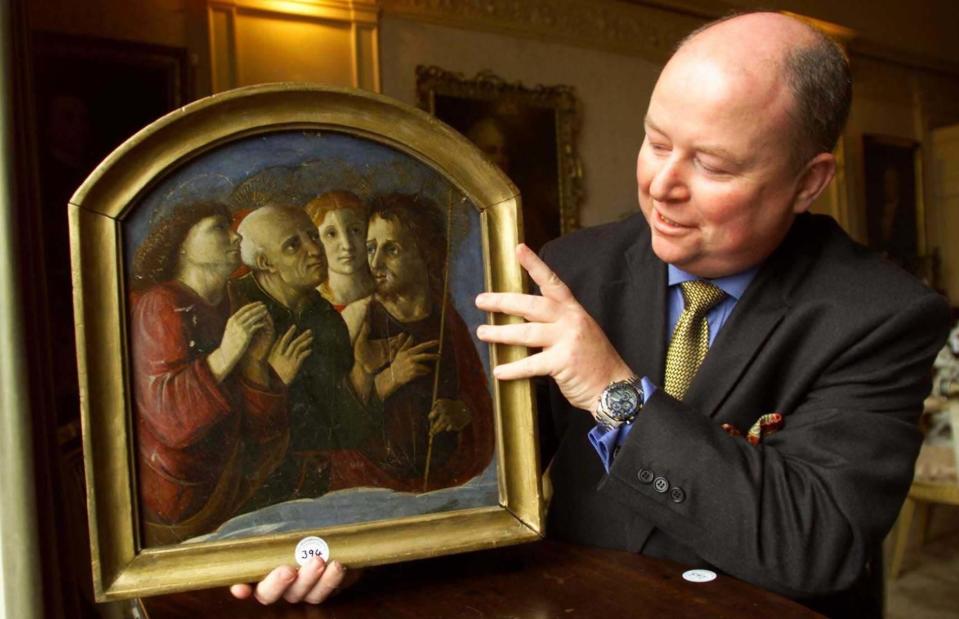
PA Images / Alamy Stock Photo
Known simply as “The General” during his heyday in Ireland’s underground criminal world, Martin Cahill orchestrated a heist at Russborough House in Ireland. Among the stolen paintings were artworks by Vermeer, Vestier, and Venetian scenes by Guardi. Eight of the stolen paintings were recovered in rented cars in 1993, but the Guardi works remain hidden.
Cahill’s criminal exploits led to his murder in 1994, and he is said to have taken details of the paintings’ hiding spot to the grave. Among the pieces that were eventually found is this Pietro de Francesco Degli Orioli painting, which was auctioned off in 1999. Guardi’s scenes are believed to be buried somewhere in the Dublin Woods, near Killakee, but art detectives haven't yet found their exact location.
Cézanne's View of Auvers-sur-Oise

Paul Cézanne/Public domain/wikimedia Commons
While the world rang in the new millennium with fireworks and celebrations, a thief took advantage of the distraction and broke into the Ashmolean Museum in Oxford, England to steal View of Auvers-sur-Oise, a landscape painting by Paul Cézanne. The artwork has a value of $3.9 million (£3m) and has been lost for almost 25 years.
It’s clear from the heist's set-up this wasn't an amateur burglary. Investigators found the thief had cut a hole in the roof of the museum, the noise of which had been covered by the New Year's Eve fireworks, and used a rope ladder to climb into the art gallery. In true crime movie fashion, they then let off a canister to create a smokescreen to obscure their work from security cameras before leaving with the painting back up the ladder. The robbery took just 10 minutes. Authorities thought they had uncovered the stolen artwork a few months later in a pub in central England, but it turned out to be a copy.
Picasso’s Le Pigeon aux Petits-Pois
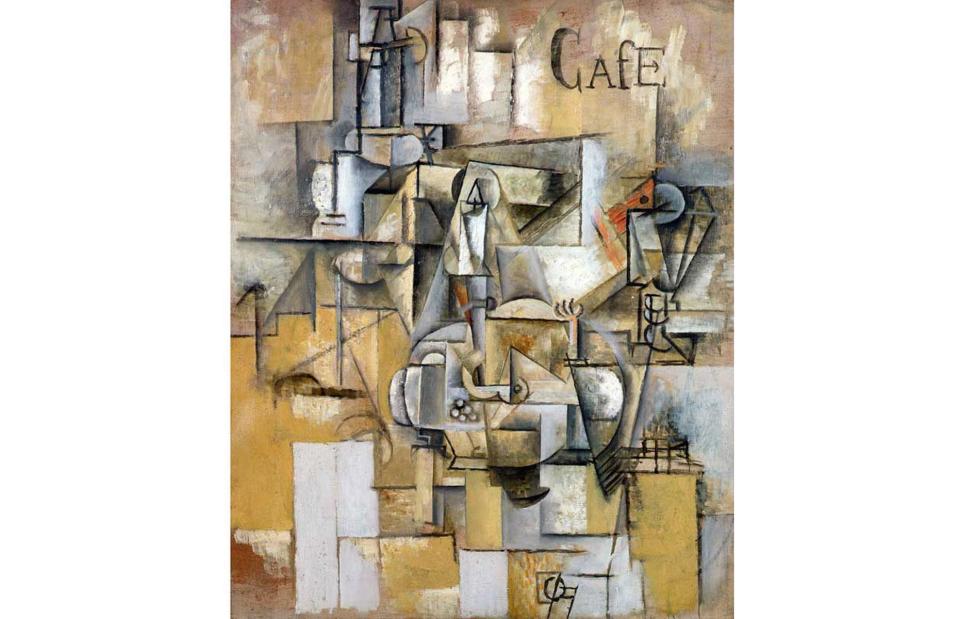
Pablo Picasso/Public domain/Wikimedia Commons
This Picasso painting was one of a collection of masterpieces stolen from the Musée d'Art Moderne de la Ville de Paris in 2010, along with a Matisse and a Braque. Together, the paintings had a value of around 100 million euros ($109m/£84m).
A culprit was arrested in 2011 and said he had thrown the extraordinarily valuable paintings into a rubbish container out of panic. The police weren’t convinced by the story and haven’t given up hope that the canvases are still out there somewhere…
220-pound ‘Big Maple Leaf’ gold coin
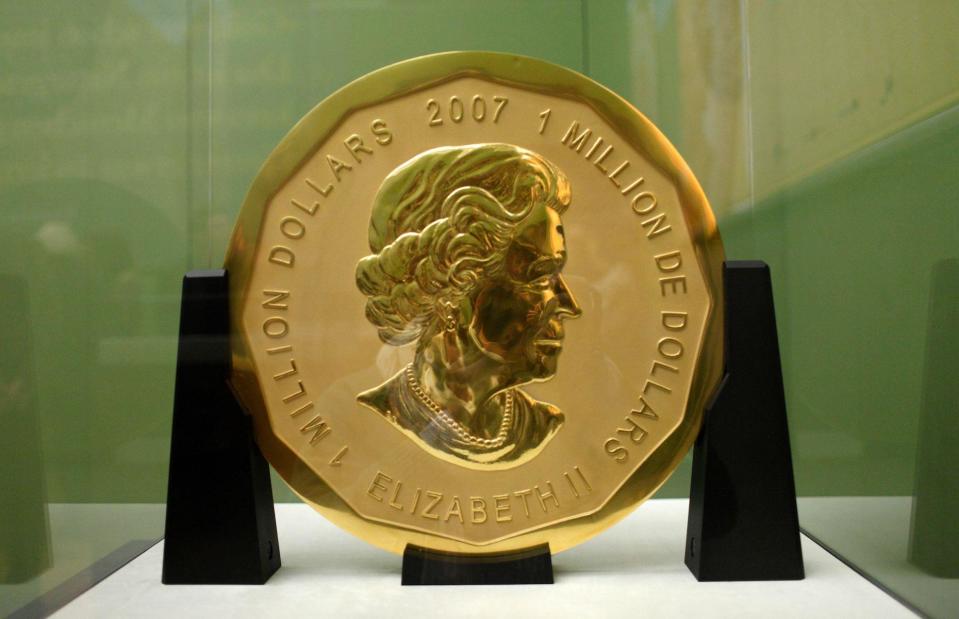
MARCEL METTELSIEFEN/DPA/AFP via Getty Images
The Big Maple Leaf is a set of six gold coins, each weighing 220 pounds. One of the coins was stolen from the Bode Museum in Berlin, Germany on 27 March 2017 – and it was quite the heist. Three thieves broke in through a window and proceeded to roll the coin, which is similar in size to a car tyre, through the museum on a skateboard, across rail tracks using a wheelbarrow and rope, and into a getaway car.
In the months after the heist, German police arrested three men from a family linked to organised crime, as well as an employee from the museum who had advised the thieves on the building’s safety precautions. The trial ended in February 2020, with the robbers receiving jail sentences, but the giant coin remains lost. There are suspicions that it may have been melted down, as gold dust was found on the criminals’ car and clothing, but it's still possible it could turn up in the future.
Van Dyck’s A Soldier on Horseback and Carraci's A Boy Drinking

Courtesy Christ Church Picture Gallery
During the night of 14 March 2020, A Soldier on Horseback (pictured), which dates back to 1616, was taken from the Christ Church Picture Gallery at Oxford University, England. The Anthony Van Dyck piece was stolen along with A Rocky Coast, with Soldiers Studying a Plan, a 1640s piece by Salvator Rosa, and Annibale Carraci’s A Boy Drinking, which dates back to 1580. Combined, the pieces are thought to be worth £10 million ($13m).
The Rosa artwork was recovered earlier this year, after a man in possession of the painting contacted Romanian police and chose to return it to the authorities. However, the man – who has not been arrested and is reportedly being treated as a witness – claims he sold the other two paintings. They are believed to be somewhere in Europe but their precise whereabouts is a mystery.
Frans Hals’ Two Laughing Boys

ILVY NJIOKIKTJIEN/ANP/AFP/Getty
Frans Hals’ Two Laughing Boys was stolen from the Hofje van Mevrouw van Aerden museum in Leerdam in the early hours of 27 August. This wasn’t the first time the painting had fallen into the hands of thieves, as it was actually stolen from the same museum back in 1988, and again in 2011. It took three years to track down the painting after it first disappeared, and six months after the burglary in 2011.
The painting, which depicts two men laughing over a mug of beer, dates back to 1626 and is estimated to be worth 15 million euros ($16m/£12.5m). It’s thought the thieves broke into the small museum through the back door. While police have been able to view CCTV footage, the painting’s location remains a mystery.
Mary Queen of Scots' rosary beads (and other treasures)
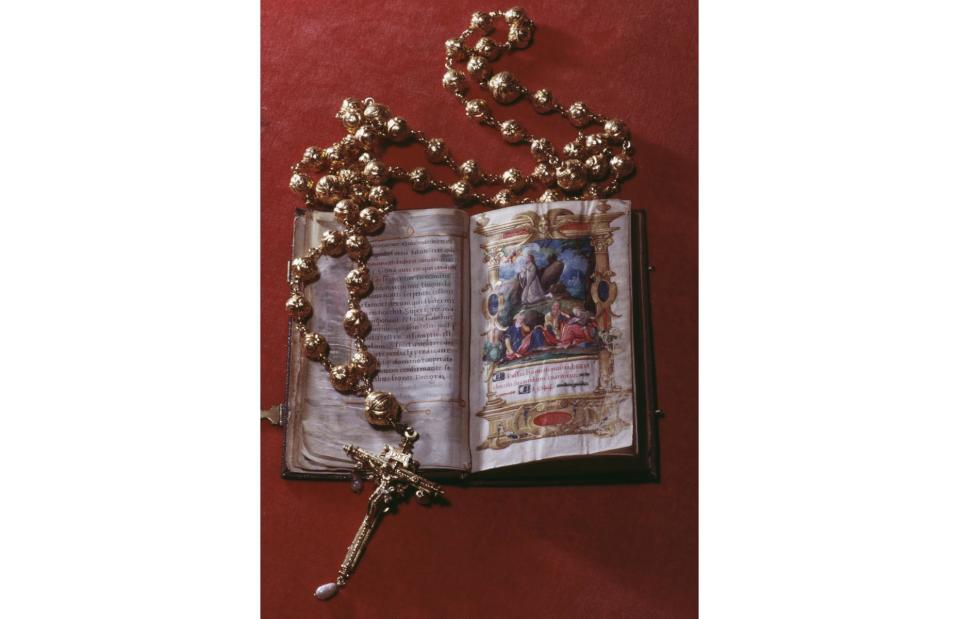
Epics / Contributor / Getty Images
On Friday 21 May 2021 at around 10.30pm, a set of rosary beads (pictured) that Mary Queen of Scots carried to her execution in 1587 was stolen from Arundel Castle in West Sussex, England. The beads as well as other gold and silver artefacts, including Mary's coronation cups, were worth as much as £1 million ($1.2m) in total, although a castle spokesperson described the haul taken by the thieves as "priceless".
The thieves are thought to have entered Arundel Castle through a window and smashed a glass cabinet in order to take the treasures. An abandoned vehicle in the nearby village of Barlavington (about 20 minutes' drive away) that had been set alight was identified by local police as "linked" to the crime and a man was later arrested, but the treasures have never been found.
Now discover how Marie Antoinette's wild spending led to her grisly demise